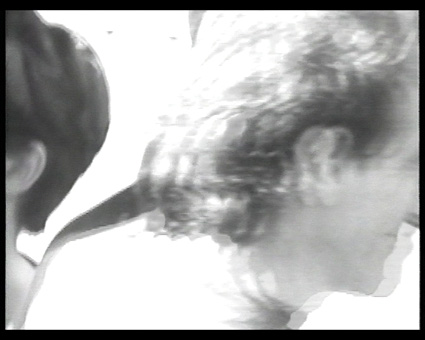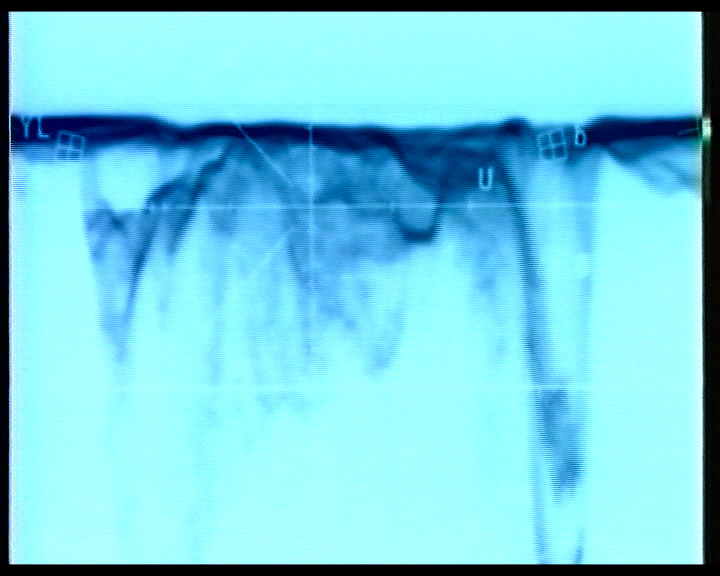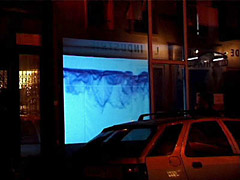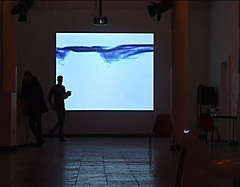femmes / messages / femmes
1998-2008, 3 parts, each 3’, colour, dv
première: Künstlerhaus Bethanien, Berlin 1999
other presentations: CC Mechelen 2006 (italian version)
Part of a work based on the photography of a plaster sculpture, a women, which was shot in Florence’s Galleria dell’Accademia. It was the basic material for a lot of photographic works and a slide-projection installation. To this diversity of images a play of French adjectives is added. Alphabetically ordened and rhythmically edited, they created images in the head, which changes by each adjective.
(3 versions: french, italian, spanish)
femmes/
Wolfgang Max Faust published a study on the relation of fine arts of the 20th century with literature called “Bilder werden Worte”– pictures become words- in 1977. The first chapter, entitled “Worte werden Bilder”, treats the »translation« of literature into painting as exemplified by concrete poetry. Over two decades after the original publication of the book, the chapterâs title needs to be extended, as contemporary art uses the creative processes of literary production. Conceptual art developed the process of transferring painting into conceptual frames. The 80’s an 90’s saw the retransformation of this frame back into painting.
Still the word-image relation remains precarious. Being all the more difficult to interpret, the more complex the media transporting word and image are. In our civilisation of today it is the case that the visual culture has become the dominant channel of perception. The word itself increasingly loses its significance and is being represented through visual equivalents. Logos and icons are a concrete manifestation of this development. Monique Thomaes answers critically to this change of values with her complex installation. The diction she works with is concrete; it is accompanied by a visual framework. Both the words and their perceived environment mutually influence each other. The words used are the French terms which could be employed to describe a woman. Arranged alphabetically and rhythmically segmented by video-cut and by the presentation, they constitute a description. The changing adjectives ceaselessly alter the evoked image. The picture created by this process is not without relevant meaning. As these adjectives are the expression of a construction of femininity, the question of the origin of this construction, of its male or female creator poses itself.
Monique Thomaes’ reply is founded on experience. Her work can be related directly to one of Judith Butler’s statements : “The culturally integrated subject is in active relation to its constructions, even though they constitute the very attributes of its identity”. As if she had wanted to describe Monique Thomaes« work Judith Butler later continues saying: “The linear enumerationâs of adjectives from constructed positions attempt to capture a situated subject without ever completely succeeding. This failure to succeed is helpful as it raises the question of the political impetus from where the “etc” often found at the end of such lines originates.
One cannot speak of failure with regard to Monique Thomaes installation, as she succeeds in restoring the validity of words and phrases by a process of visualisation in which she takes recourse to a means of presentation which turns words into images. In glass-plates surrounding the screens, the spectator sees the mirror image of the text. This detail exemplifies the artistâs critical attitude towards the word-image relation, as it requires the spectator to explore the space in which the text is presented. On some screens the words can be read normally. The text relates in the same way to the surrounding space as the space creates a relation to the text. This clarifies one fundamental aspect of Monique Thomaes« relation to the medium in her works.
Very much in the same way as when the lexicon turns into a picture the works of Monique Thomaes are specific transpositions. The term transposition is to be understood as the process of giving content to a specific medium which it formerly did not inherently posses.
By actually being used to refer to something outside itself, the respective medium reflects itself. The installation “messages-femmes-” shows the word as a picture by simultaneously reflecting it with a mirror on the instance of its presentation. The work “o.t.” (1996) also exemplifies this attitude. Here an oscillographic wave-line represents the video images of three timed slide projectors operating. These transpositions allow recourse to means of deciphering and disempowering a visual culture.
The installation “messages-femmes” exemplifies this by visualising mirror images. Here words suddenly turn into words again and pictures turn back into pictures, because words are turned into pictures and the underlying process is demonstrated. This process is endless to the same extend as words do not imply complete representation. “This “etc.” is the necessary supplement to any attempt to permanently define identity.”
femmes/
Wolfgang Max Faust published a study on the relation of fine arts of the 20th century with literature called “Bilder werden Worte”– pictures become words- in 1977. The first chapter, entitled “Worte werden Bilder”, treats the »translation« of literature into painting as exemplified by concrete poetry. Over two decades after the original publication of the book, the chapterâs title needs to be extended, as contemporary art uses the creative processes of literary production. Conceptual art developed the process of transferring painting into conceptual frames. The 80’s an 90’s saw the retransformation of this frame back into painting.
Still the word-image relation remains precarious. Being all the more difficult to interpret, the more complex the media transporting word and image are. In our civilisation of today it is the case that the visual culture has become the dominant channel of perception. The word itself increasingly loses its significance and is being represented through visual equivalents. Logos and icons are a concrete manifestation of this development. Monique Thomaes answers critically to this change of values with her complex installation. The diction she works with is concrete; it is accompanied by a visual framework. Both the words and their perceived environment mutually influence each other. The words used are the French terms which could be employed to describe a woman. Arranged alphabetically and rhythmically segmented by video-cut and by the presentation, they constitute a description. The changing adjectives ceaselessly alter the evoked image. The picture created by this process is not without relevant meaning. As these adjectives are the expression of a construction of femininity, the question of the origin of this construction, of its male or female creator poses itself.
Monique Thomaes’ reply is founded on experience. Her work can be related directly to one of Judith Butler’s statements : “The culturally integrated subject is in active relation to its constructions, even though they constitute the very attributes of its identity”. As if she had wanted to describe Monique Thomaes« work Judith Butler later continues saying: “The linear enumerationâs of adjectives from constructed positions attempt to capture a situated subject without ever completely succeeding. This failure to succeed is helpful as it raises the question of the political impetus from where the “etc” often found at the end of such lines originates.
One cannot speak of failure with regard to Monique Thomaes installation, as she succeeds in restoring the validity of words and phrases by a process of visualisation in which she takes recourse to a means of presentation which turns words into images. In glass-plates surrounding the screens, the spectator sees the mirror image of the text. This detail exemplifies the artistâs critical attitude towards the word-image relation, as it requires the spectator to explore the space in which the text is presented. On some screens the words can be read normally. The text relates in the same way to the surrounding space as the space creates a relation to the text. This clarifies one fundamental aspect of Monique Thomaes« relation to the medium in her works.
Very much in the same way as when the lexicon turns into a picture the works of Monique Thomaes are specific transpositions. The term transposition is to be understood as the process of giving content to a specific medium which it formerly did not inherently posses.
By actually being used to refer to something outside itself, the respective medium reflects itself. The installation “messages-femmes-” shows the word as a picture by simultaneously reflecting it with a mirror on the instance of its presentation. The work “o.t.” (1996) also exemplifies this attitude. Here an oscillographic wave-line represents the video images of three timed slide projectors operating. These transpositions allow recourse to means of deciphering and disempowering a visual culture.
The installation “messages-femmes” exemplifies this by visualising mirror images. Here words suddenly turn into words again and pictures turn back into pictures, because words are turned into pictures and the underlying process is demonstrated. This process is endless to the same extend as words do not imply complete representation. “This “etc.” is the necessary supplement to any attempt to permanently define identity.”
femmes/
In the 1997 work “Femmes” which uses – as did the 1994 installation “Blauäugig” – the static picture of photography as well as the time sequence of the slide switch, Monique Thomaes exposed the photographic representation of a woman’s breast in literally meticulous manipulations. With precise data, she organized the gradually ascending and descending exposure times as regards the reproduction of negatives, thereby reaching into every zone where the motive dissolves either into light or darkness, thus visually vanishing from the surface. The timing of the projection of the transparencies is carried out according to a precise rhythm; however this is not singled out as information concerning the work. This precision of procedure is the basis for the analogous picture producing apparatuses (aperture/exposure time) which Thomaes applies in her capacity as an artist. It is a method according to measure, and a measure giving method. The confrontation arising here leads to creations in which the extremes of control/pressure and loss/dissipation are dealt with. It is precisely these works which tend to exclusively investigate the relationship between time and image (slide switch/ video), thus revealing the escalation of the catastrophic (cf. “Point De Vue”, “Hombre”) as a delirium with an equally dangerous as well as seductive, demanding absorption and exhausting, dynamic …
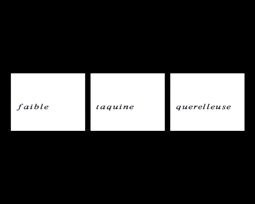
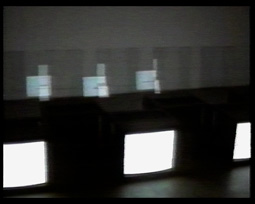
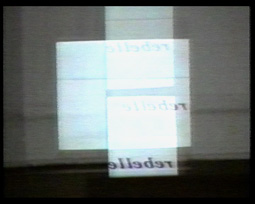
installation view Bethanien 1999

